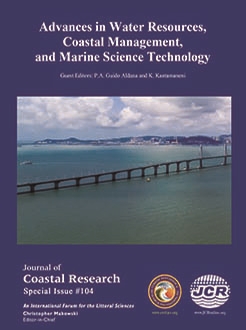Xing, W.X.; Liu, D.H., and Li, F., 2020. Urban circle structures and regional differences in China's coastal areas. In: Guido Aldana, P.A. and Kantamaneni, K. (eds.), Advances in Water Resources, Coastal Management, and Marine Science Technology. Journal of Coastal Research, Special Issue No. 104, pp. 554–565. Coconut Creek (Florida), ISSN 0749-0208.
As a geographic element, oceans and seas exert a profound impact on regional social and economic development and change, and they are key factors that drive the formation and development of urban spatial structures in coastal areas. Based on the wide applicability of the “lake effect” theory to water economy research, this study analyzes the spatial structure characteristics of 735 counties in 11 provinces and municipalities in mainland China's coastal areas and the differences among three major coastal areas using buffer analysis and an extended Bass model. The results show that there is a notable urban circle structure in China's coastal areas under the influence of seas. China's coastal areas can be divided into three circular zones, namely, the core, key, and peripheral zones. The landward boundaries of core and key zones are 9 and 95 km away from the coastline, respectively. The landward boundary of the peripheral zone is the peripheral boundary of the study area. There is a significant difference in the spatial circle structure between the Northern, Central, and Southern coastal areas of China. In the Northern region, the core zone lacks a notable circle structure, whereas there is a notable dual-peak, dual-nuclei structure in the key and peripheral zones. The core zone width of the Central region is 15 km, and there is a dual-peak (high and low peaks), dual-nuclei structure in the key and peripheral zones. In the Southern region, the width of the core zone is 9 km, and there is a high-peak, single-nucleus structure in the key zone. The results of this research are helpful to clarify the position of different cities in regional development, and provide theoretical basis for land and sea resources allocation.





